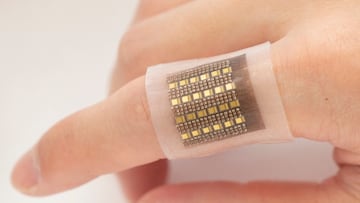The skin patch capable of detecting cancer, heart attacks or bleeding: this is how it works
This new technological gadget has been developed by engineers from the University of California to continuously monitor diseases and save lives.

Nature has published research carried out by engineers at the University of San Diego, in California, who have developed a soft photoacoustic patch, a kind of technological band-aid that performs three-dimensional mapping of hemoglobin in deep tissues.
It does this through an array of ultrasonic transducers and Vertical Cavity Surface Emitting Laser Diodes (VCSELs) on a common soft substrate. When illuminated by the VCSEL laser, the hemoglobin will vibrate and emit acoustic waves to achieve high spatial resolution biomolecule mapping in deep tissues.
How Band-Aid Technology Works
- This portable and flexible patch adheres to the skin like a plaster, and allows for long-term, non-invasive monitoring.
- It performs three-dimensional mapping of hemoglobin with sub-millimeter spatial resolution in deep tissues, down to centimeters below the skin, compared to other portable electrochemical devices that only detect biomolecules on the skin’s surface.
- In addition, you can achieve a high contrast in relation to other fabrics.
- Due to its optical selectivity, it can broaden the range of detectable molecules, integrating different laser diodes with different wavelengths, along with their potential clinical applications.
After one hour of operation, the maximum temperature measured was roughly 96.8ºF (36°C), slightly higher than skin surface temperature, but still comfortable for the subject. The photoacoustic patch generates as much heat as phased ultrasound arrays, but within safety standards.
The photoacoustic patch only detects, for now, hemoglobin, a technology that can potentially be extended to monitor many other endogenous biomolecules, such as melanin, glucose, lipids, cytochrome, nucleic acid, and protein. For visceral organs, such as the heart, for example, the wavelength needs to increase, something that Verasonics is working on. In the same way, discovering cancer in a person as early as possible would be essential to save a person’s life.






